Recreating the Country blog |
|
Helen Scott is guest blogger & photographer for May Autumn in southern Australia couches memories of cosy nights by an open fire, cool crisp sunny days and deciduous trees displaying colourful autumn leaves. For some of us it may also provide the opportunity to explore our alpine regions and all that they have to offer. This month guest blogger Helen Scott takes a close look at the world of Snow Gums. Some of her photographs were taken in the Kosciuszko National Park. I came across Helen’s photo essay in an edition of the Newham & District Landcare Group’s newsletter, which I highly recommend for its great articles on a diverse range of topics. Helen is the group’s secretary and she has a passion for Snow Gums. I know you will enjoy her writing and beautiful photography in her photo essay.  Snow Gum at Ramshead in the Kosciuszko National Park Snow Gum at Ramshead in the Kosciuszko National Park For the love of Snow Gums, Eucalyptus pauciflora The Snow Gum is amongst the hardiest of all Eucalypt species, most commonly thought of as high country trees and often pictured in snow in Alpine regions, like this at Ramshead in Kosciuszko National Park (KNP). 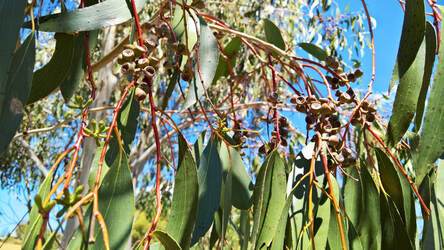 A distinctive feature of the leathery leaves is that the veins run parallel to the mid-rib (click on the image to enlarge) A distinctive feature of the leathery leaves is that the veins run parallel to the mid-rib (click on the image to enlarge) Snow Gums are quite wide spread Sometimes called White Sallees, Snow Gums are in fact spread throughout Victoria, the ACT, Tasmania, NSW to just over the Queensland border, and a few in South Australia near Mt Gambier. In Victoria they occur mainly in sub-alpine woodlands. There are 6 subspecies of Snow Gum, all present in Victoria, but the most widespread is Eucalyptus pauciflora subsp. pauciflora. Eucalyptus pauciflora subsp pauciflora (Latin, 'pauci', meaning 'few' and 'florus' meaning 'flowered') This usually has a somewhat crooked trunk and many twisted branches, and can grow to 30 metres. It is distinguished by the smooth bark which can be green, grey and cream often with ‘scribbles’. The leathery leaves are long with a curving shape, are glossy green and glisten in the sun, with distinctive longitudinal veins. A distinctive feature is that the veins run parallel to the mid-rib, the only local eucalypt that has this feature. The fruit is thick-rimmed and pear-shaped after lovely and profuse white flowers. Locally it is a mallee or open tree growing to 15-20 metres. 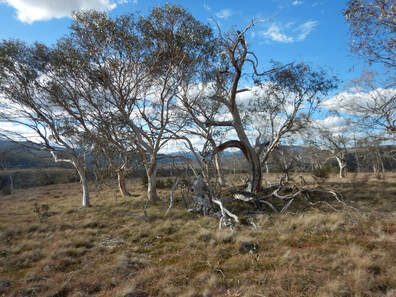 Eucalyptus pauciflora subsp. niphophilla Eucalyptus pauciflora subsp. niphophilla E. pauciflora subsp niphophilla This photo was taken in summer walking at our favourite spot in the KNP on Currango/Gurrangorambla plain where we have holidayed for over 40 years. It is most likely Eucalyptus pauciflora subsp. niphophila. (niphophila is Greek for 'snow lover')  Eucalyptus lacrimans, Weeping Snow Gum. Photo David Dyson Eucalyptus lacrimans, Weeping Snow Gum. Photo David Dyson Eucalyptus lacrimans On the same plain as above is most likely Eucalyptus lacrimans - Weeping Snow Gum, which some call Whipsticks. (Lacrimans is Latin for weeping) A small tree with a sparse crown, it is restricted to the high plains in the Adaminaby-Kiandra-Rules Point district in the KNP where Currango is located. It differs from E. pauciflora by its relatively slender trunks, open crowns and often pendulous branches. It tends to grow in small pure stands. The other subspecies of E. pauciflora are acerina (Baw Baw plateau), debeuzevillei (KNP-ACT), hedraia (Falls Creek), niphophila (highest ranges), and parvifructa (Grampians). Some Snow Gums are magnificent specimens Snow Gums are among my favourite trees so I get excited when I see magnificent specimens close to home like these pictured below on the Campaspe River in Ashbourne and at a property in Hennebergs Road, Macedon Ranges. There are relict sites in the Macedon Ranges – on the tops of Mt Macedon, Hanging Rock, the Jim, along Bolgers and Hennebergs roads and scattered specimens on other properties and roadsides between Woodend and Kyneton. A relic of the last ice age Ecologist Karl Just pointed out to me that the presence of widely scattered, small and isolated populations of Snow Gum across parts of lowland Victoria such as Newham, which suggests that these are remnants from the colder period during the last Ice Age, when Snow Gum would have been much more widespread. As the species contracted with the warming of the climate, it remained in scattered cooler pockets. These remnants are now obviously at threat from climate change. It is also interesting that in Tasmania, Snow Gum is only found in the warmer eastern half of the State. It is another cold climate specialists such as E. coccifera that occupy the alpine zone. Karl assumes that this is because Tasmania is even colder and was largely covered in glaciers during the Ice Age. Further adaptation and speciation was required to occupy the colder highlands. As per the threat from climate change, I noted Snow Gums dying on Henneberg Road. In the years after the 2009 drought some have died but I have replanted many. The species does regenerate from seed, by epicormic shoots below the bark and from big storage organs called lignotubers at its base. 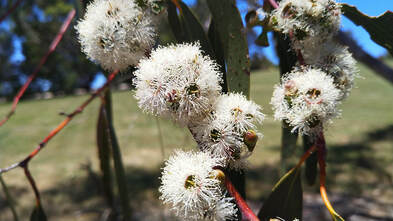 Snow Gums in flower Snow Gums in flower Plant a Snow Gum in your garden Snow Gums can be great in medium to large gardens with bark being a major feature. The growth habit is usually determined by the location in which it is grown. According to Gardening Australia; “...in the home garden, they can be trained, manipulated and even espaliered to recreate some of these forms seen in nature. They will also respond strongly to a heavy prune once established, meaning the magnificent multi-trunks can be replicated.” Click here to watch (1.5min)  Eucaluptus pauciflora, 'Edna Walling Little Snowman' in the authors home garden, winter 2020 Eucaluptus pauciflora, 'Edna Walling Little Snowman' in the authors home garden, winter 2020 Snow Gum hybrids are available from specialist nurseries. You may have noticed E. pauciflora ‘Edna Walling Little Snowman’ planted as a street tree in Woodend in Ballymower Mews - it is smaller and semi-weeping with patches of grey, white and reddish-pink bark in older growth on small trunks. (I don’t know what Edna would make of all the varieties of plants that have taken her name) According to Austraflora “Eucalyptus Little Snowman is an elegant choice of tree for your garden. Small and semi-weeping, with a clean creamy-white trunk and branches, a canopy of glossy grey-green leaves, and massed spring-to-summer bird-attracting creamy white flowers". "Eucalyptus Little Snowman has a presence in any landscape large or small. It provides screening and summer shade, and will deal with the coldest conditions (frost and snow) as well as sub tropical, in well drained clay loam. It’s great in near-coastal sites too. If you’ve got some space, Eucalyptus Little Snowman loves company, so a copse of them would be spectacular.”  The beautiful smooth patterned trunk of a mature Black Sallee, Euc stellulata The beautiful smooth patterned trunk of a mature Black Sallee, Euc stellulata To read more about Snow Gums click on these sites to explore: Extra note: The Snow Gums on the Gippsland Plains are related to those of the high country in Victoria, however ecologists suspect the Gippsland Plains form could be a new sub-species. This is because the populations have been separated for millennia and opportunities for gene flow have been very limited. A note from Helen Scott. This does not purport to be a scientific article, but is written to share my fascination with an iconic species. Stephen has adapted it and added some additional comments.
3 Comments
Julie Cameron
15/10/2021 10:15:47 am
Loved reading the Blog about Snow Gums (Helen Scott guest blogger) This has spurred me to contact locals and the Golden Plains shire to recognize and protect a remnant patch of E. pauciflora on the corner of Bamganie Rd & Mt Mercer Rd near Meredith.
Reply
Steve
15/10/2021 05:46:36 pm
Good to hear from you Julie,
Reply
Helen Scott
17/10/2021 01:20:11 pm
Thanks Julie, great to hear about your remnant patch - I have friends in Meredith. I am now involved as Newham Landcare in a joint research project with Macedon Ranges Shire Council on Snow Gums and climate change, with 2 ecologists appointed to assess health etc. We will be logging specimens on INaturalist.
Reply
Leave a Reply. |
Click on the image below to discover 'Recreating the Country' the book.
Stephen Murphy is an author, an ecologist and a nurseryman. He has been a designer of natural landscapes for over 30 years. He loves the bush, supports Landcare and is a volunteer helping to conserve local reserves.
He continues to write about ecology, natural history and sustainable biorich landscape design. 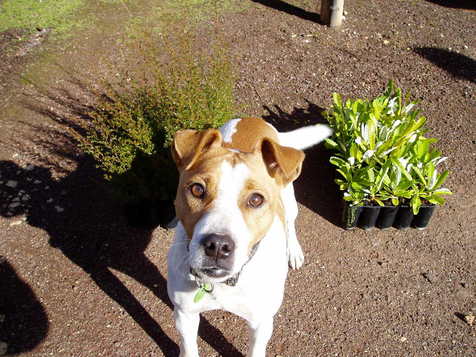
|
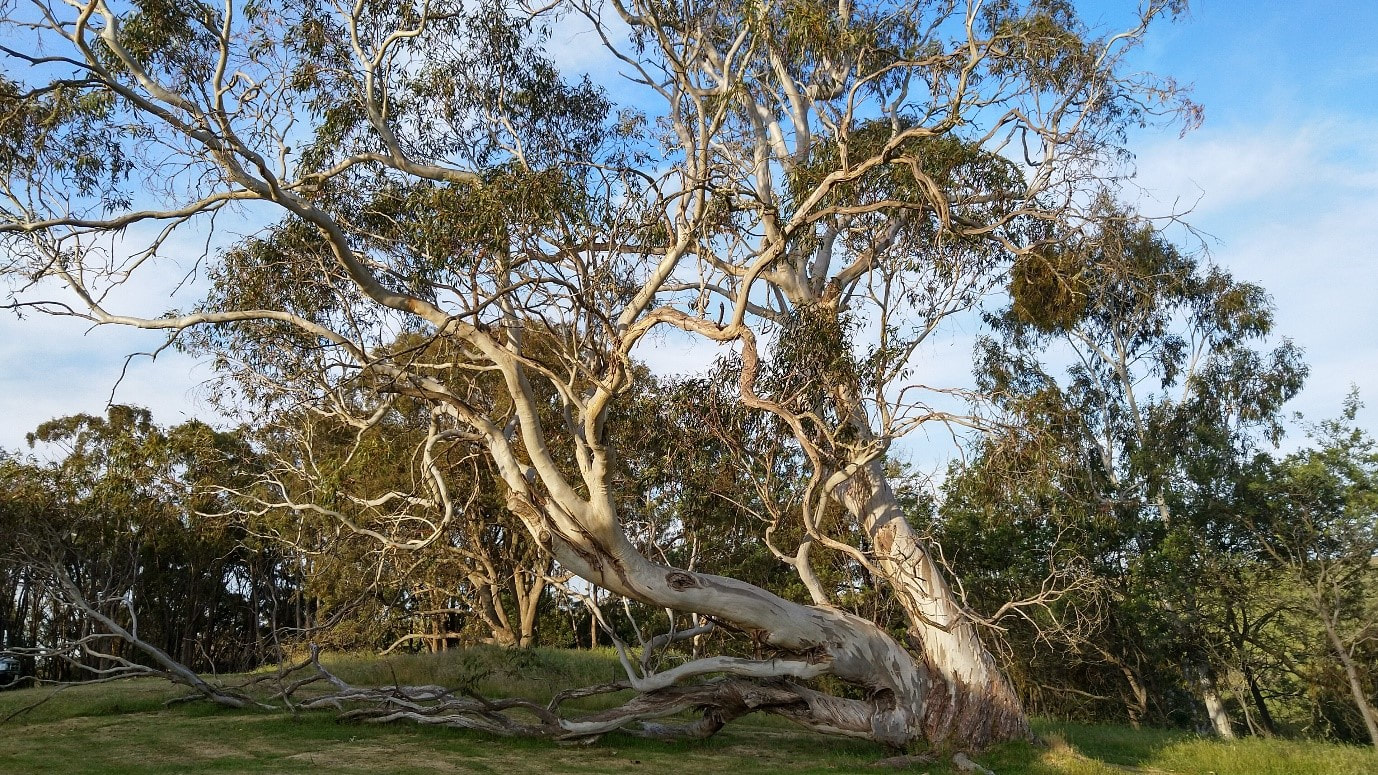
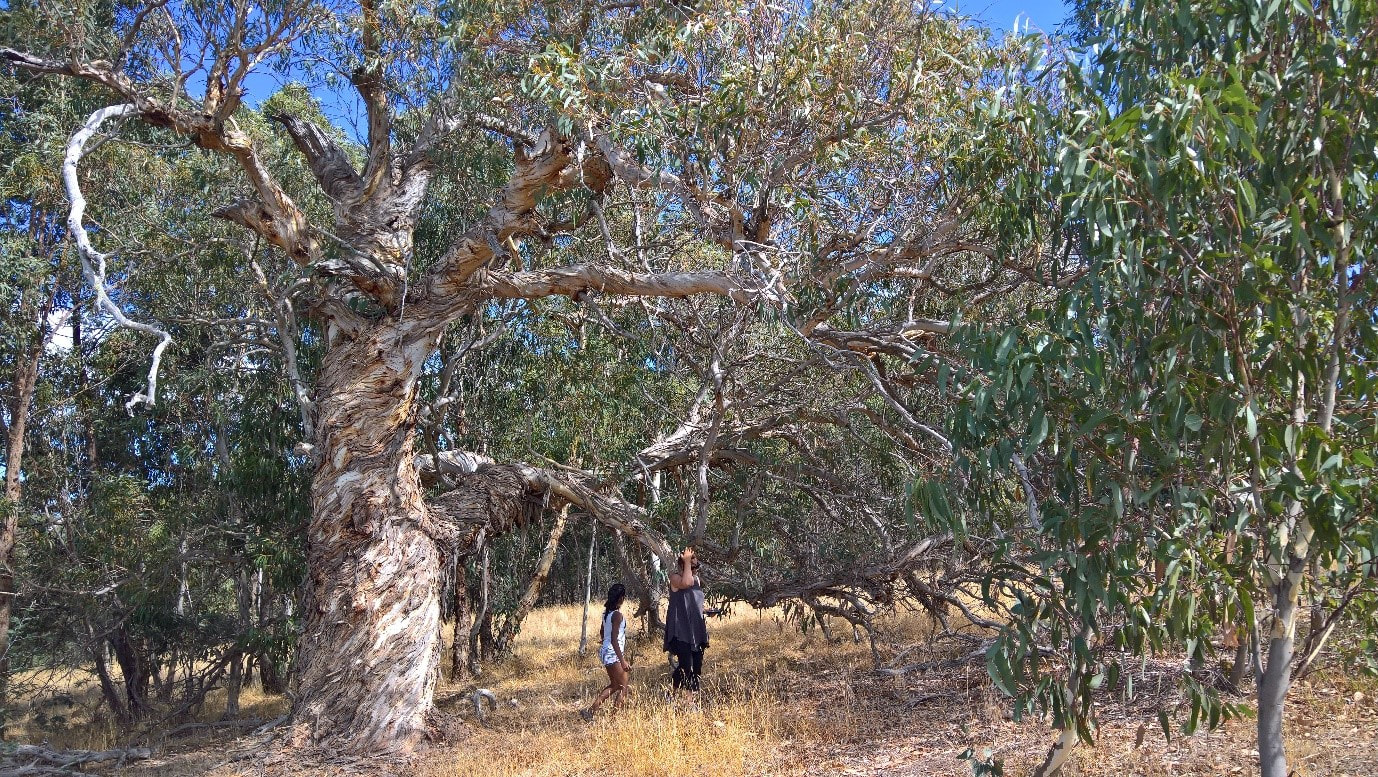
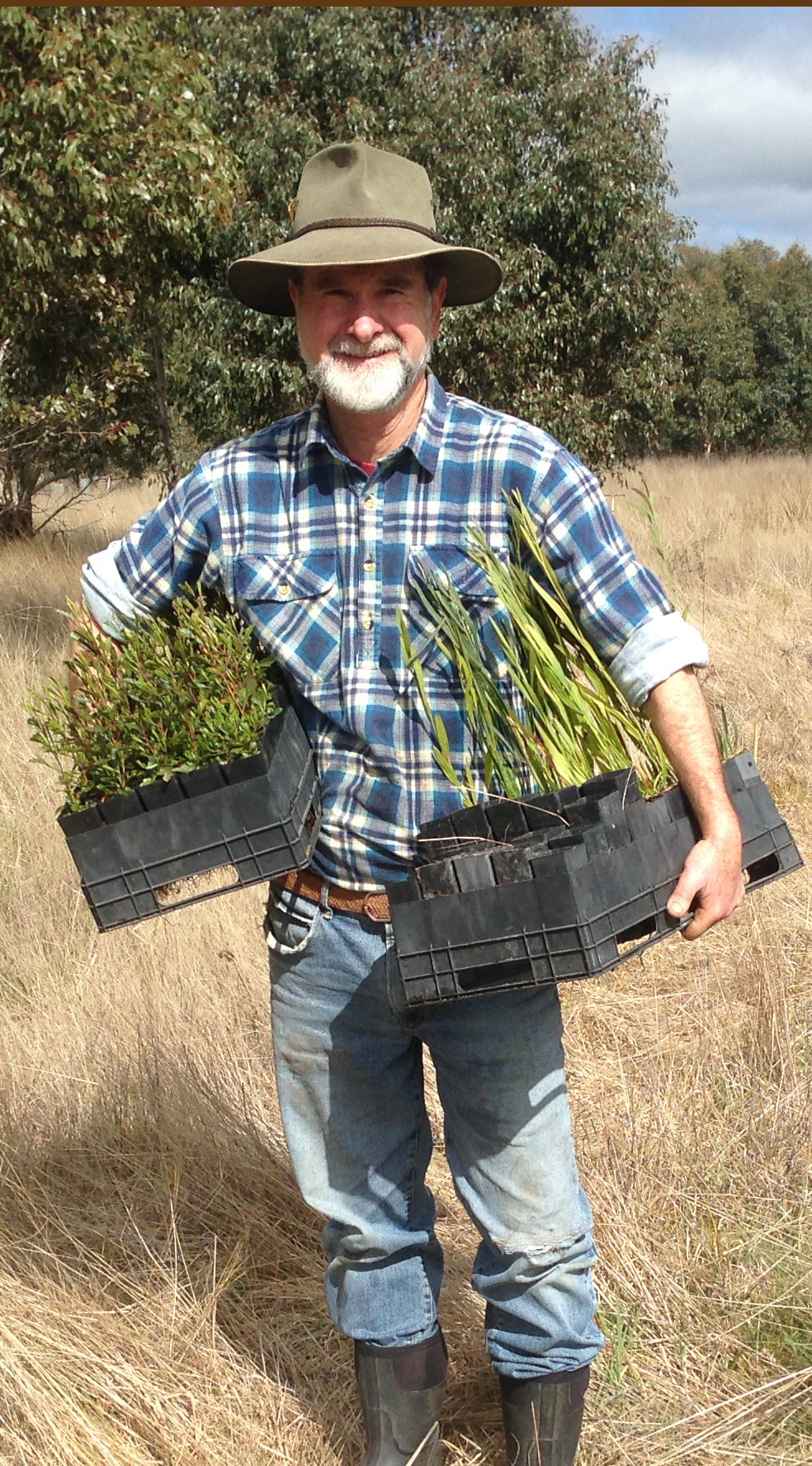

 RSS Feed
RSS Feed
